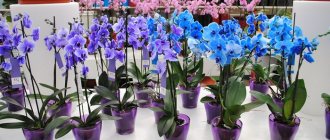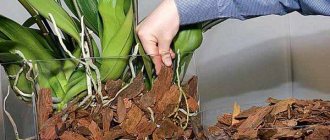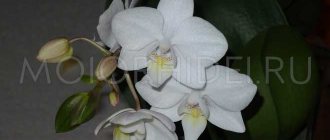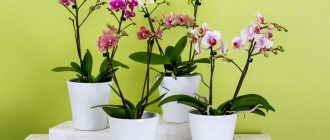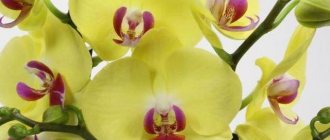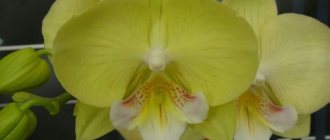Phalaenopsis is probably the most popular orchid among amateur gardeners. There is nothing surprising here - after all, the diversity of species and hybrid varieties in this genus is amazing. This same circumstance significantly complicates the choice for people just starting to create their own personal collections. If you are looking for where to learn about phalaenopsis, want to see photos with the names of varieties, then read this article and be sure to go to the special section of our website - everything is here.
Flower birthplace and origin
In nature, these plants can be found in Asia, Australia, the Philippines, and in places with a humid tropical climate.
The genus owes its name to K. Blume, the director of the botanical garden, who at dusk mistook an orchid flower for a butterfly. Phalaenopsis is a Greek word meaning “moth-like.” And indeed, in its shape it resembles this fragile creature.
In Ancient Greece they saw another similarity, with a slipper or shoe. However, such elegant shoes are not suitable for earthly creatures. She is worthy only of the feet of the Goddess of Beauty. Hence the name - Aphrodite's slipper.
Changing color at home
A frequent, but still inexplicable from a scientific point of view, phenomenon in which the color of a flower changes. Possible reasons for this phenomenon are explained by the following possible factors:
- artificial coloring by sellers , which wears off over time, is washed off, or for some other reason comes off and returns to its natural color;
- insufficient lighting can provoke a change in brightness and color saturation, which creates a deviation in color;
- oversaturation of expensive complex fertilizers by sellers containing microelements that affect the intensity and richness of flowering. At home, the nutrition gradually loses its strength and the flower takes on its original appearance;
- changes in growing conditions : lighting, rearrangements, stressful moments, all this can affect color changes;
- the natural component is when, as the flower blooms, the color shade changes.
You never know how the bloom will turn out. Will the flowers be large or small, rich in color or dull? Environmental factors, conditions and care present surprises every time.
Application
For a long time in the East, these delicate plants were highly valued for their medicinal properties and were used to relieve severe pain and treat many diseases. It was also believed that potions made from the flower could prolong life.
Modern scientists have confirmed the medicinal properties of orchids. The assumption about the plant’s ability to give longevity has also been scientifically confirmed. It turned out that Phalaenopsis roots contain substances that activate the synthesis of the longevity gene. The presence of these substances explains their long flowering.
Today this flower is revered as a highly decorative plant and decorates our interiors.
Fertilizer for orchids
It is necessary to feed the orchid only during the growth period, no more than once every two to three weeks with special fertilizers “Bona Forte, Greenworld, Pocon”. The main thing is not to overdo it (follow the proportions indicated on the package). The orchid does not tolerate the concentration of mineral salts in the substrate; to avoid this, during the feeding period, rinse the substrate with clean water, alternating feeding and washing every 1 - 2 weeks.
Fertilizer for orchids can be purchased at a flower shop. Do not use fertilizers intended for other plants to feed orchids. Do not fertilize the orchid during the dormant period and cold season.
Ideally, fertilizers for orchids are not required at all, since the flower receives all its nutrients from the substrate, but only if you replant (change the substrate) once every 2 years. Experts have proven that excessive feeding of orchids reduces immunity, and the plant is more susceptible to diseases and pests.
Description of the plant
Phalaenopsis is an epiphytic plant of the Orchidaceae family.
Orchid grows on tree trunks and even rocks
The roots of Phalaenopsis both in their purpose and in structure. They are divided into main and subordinate ones. With the help of the main roots, the plant is attached to the tree trunk and always grows vertically, upward. Adventitious roots are located between the leaves and are aerial.
Sometimes they look very exotic, forming a “beard”
Like leaves, roots are capable of photosynthesis. This explains their unusual gray-green color for roots and their special structure, reminiscent of the tissues of succulent leaves that can retain moisture.
Orchids have a short stem with sessile large (from 7 to 30 cm) dense leaves of a rounded elongated shape located on it in pairs. On adult specimens there are from 4 to 6. During each year, 2 leaves appear, increasing the overall height of the plant.
The flowering of a plant begins with the appearance of a peduncle. It can branch, stretching up to 70 cm, and bears a large number of buds.
Thanks to the sequential opening of the buds, the flowering of orchids lasts for several months.
Phalaenopsis
The flower consists of 3 lateral sepals (sepalia), 2 lateral petals (petalia) and a central part, the so-called lip. Its task is to attract and accept, like a “landing site,” pollinating insects.
Phalaenopsis flowers can have the most incredible shapes and colors
Rules of care
Creating optimal living conditions is not the only requirement that should be taken into account when growing black phalaenopsis. Watering and fertilizing are also very important aspects, the regime of which must be carefully observed and controlled.
Watering
Being tropical plants, orchids prefer moist, but not wet, soil. The substrate in the pot should not be allowed to dry out, as this will cause the phalaenopsis to wither and its flowers to fall off.
It is advisable to water with soft water at room temperature. Flower growers usually use rain or settled water. A regular drinking filter will help soften hard water. Watering plants with cold water or using water directly from the tap is strictly prohibited.
The fact that a black orchid needs watering can be determined by the condition of its roots. When there is a lack of moisture, the roots of the plant become gray-green in color.
The watering regime should be regular, but it is important for the grower to avoid overmoistening the substrate. The following signs indicate that the plant is being over-watered:
- yellowing of leaves;
- wilting of the bush;
- rotting and blackening of roots.
Species composition
The genus Phalaenopsis is diverse and has about 70 species of plants, differing in size, color of leaves and flowers. Several of them are found indoors.
Phalaenopsis nice
A medium-sized species, distinguished by long, up to half a meter, leaves, painted in dark shades of green. It blooms twice a year, shooting out a peduncle with many buds.
Large white flowers with a yellow or reddish lip develop from the buds
Phalaenopsis Schiller
Differs in leaf color. Their lower part has a reddish tint.
The upper side of the leaves is covered with dark green spots
The graceful buds of this orchid are painted in white and purple tones, the central part has a leopard color.
Flowers of plants of this species are the height of grace
Phalaenopsis Stewart
It is characterized by a branching peduncle and unusual flower color.
The petals are white and the lip is golden yellow with bright purple spots.
Phalaenopsis Luddemann
Differs in compact sizes. Its leaves (up to 25 cm) are colored light green, and the peduncle bears no more than 7 buds.
Small (up to 7 cm) pink and lilac flowers exude a pleasant delicate aroma
The undeniable advantage of this species is its long flowering, almost all year round.
Phalaenopsis giant
It is impressive in its size: the leaves grow up to 1 meter in length. The plant throws out several flower stalks, each of which reaches at least half a meter.
Peduncles bear more than a dozen buds
Variety of varieties
Although white is one of the most popular colors among gardeners, pure white is extremely rare. Basically, it has some color splashes or a different colored edging.
It is believed that the “Amabilis” variety became the progenitor of many varieties and hybrids of this orchid variety. It is impossible to list all the hybrid varieties due to their diversity, but the most popular are:
- "Adelaide"
- "Alabaster";
- "Alaska"
- "Bristol"
- "Cotton Candy";
- "Anthyra Darwin";
- "Christa Wichmann";
- "Cristella"
- "Diamond"
- "Formosa Dream";
- "Gold Lip";
- "Island"
- "Japanese Heart"
- "Kiska"
- "Malibu Chablis";
- "Madonna"
- "Memories"
- "Misty Mountain"
- "Polar Bear"
- "Prima Piano"
- "Ragen"
- "Salt Lake"
- "Samoa"
- "Soft Cloud" etc.
They can have different flower sizes - from large (Royal) to small (mini Mark). The size of the plant itself is also varied, from mini to 1 m.
Growing
There is an opinion that orchids are capricious, finicky and require careful care. This deters many from purchasing them. There is some truth to this assumption. For favorable growth, Phalaenopsis requires high humidity air, which is problematic for most rooms, especially in winter.
Air humidity requirements
Humid air, from 50% and above, is what this beauty needs, first of all . Otherwise:
- its leaves and roots will lose their elasticity;
- the roots will acquire a grayish tint and lose their elasticity. They will not restore their structure and color even after watering;
- the plant will drop its buds and refuse to bloom.
Urgent measures to humidify the air can be:
- a container of water placed in close proximity to the orchid;
- batteries covered with a damp cloth;
- spraying the plant repeatedly throughout the day.
Optimal temperature conditions
Phalaenopsis feels good at air temperatures from 15 to 25 ° C. It is important for him:
- absence of nearby heat sources, for example, central heating radiators. In close proximity to them, the plant does not bloom so readily.
- Elimination of not only the action, but also the occurrence, even short-term, of drafts.
Keeping orchids at temperatures below 12 degrees is detrimental.
A favorable moment for the development of Phalaenopsis is the difference between night and day air temperatures of at least 5 degrees.
Lighting
Phalaenopsis prefers bright places and long daylight hours (up to 12 hours), so in autumn and winter the plant will benefit from additional lighting.
With a lack of light (for example, short daylight hours), the plant goes into hibernation: it stops growing and blooming. The orchid leaves begin to stretch and darken.
The plant will “tell” about excess light by the appearance of plaque and spots on the leaves.
It is important to comply with one more condition: Phalaenopsis does not tolerate rearrangement. For her, any movement is stress, to which the plant can react by slowing growth and dropping buds.
Features of watering
1. Watering is carried out when the substrate is completely dry.
To determine the need for moisture, move away the top part of the soil, usually these are pine needles or pieces of bark, and feel the underlying layers.
Orchid does not tolerate waterlogging very well. Stagnation of water is unacceptable for it: the roots of the plant quickly rot. Less scary for her are “dry” periods, which can last from several weeks to a month. It will signal insufficient watering by drying out the tips of the leaves.
2. Phalaenopsis is watered “from below”, immersing the pot in a container of water.
It is advisable that the water level coincides with the edges of the pot. In order to “get enough” of water, an orchid needs 30-40 minutes. The pot is removed, allowing the water to drain thoroughly. If water gets into the axils of the leaves, it is carefully removed.
It remains to add that for irrigation you can only use soft, settled, or even better, filtered or boiled water.
Transfer
Phalaenopsis does not need frequent replanting: once a year is enough. It is better to replant an orchid immediately after the plant has finished flowering.
Transplant instructions
Carefully remove the orchid from the container. To do this, carefully remember the container from the sides. You can turn the pot upside down, keeping the plant from falling, or cut the pot with a knife. In any case, you should protect the roots from damage as much as possible.
Clean the roots from the substrate, carefully untangle them and carefully inspect them.
- Healthy roots are green. They are dense and hard.
- Diseased and dead roots are easily recognized by their darker color and “emptiness” to the touch.
The following are subject to removal:
- rotten, dried and damaged areas. It is better to treat the roots with a sharp knife disinfected in an alcohol solution, followed by treating the cuts and cracks with activated carbon or brilliant green.
- All old leaves and flower stalks.
3. After the manipulations, the plant is given time to recover, leaving for 2-3 hours.
At this time, prepare the container and substrate.
Recommendations for choosing a pot and substrate
The choice of pot is of great importance. By their nature, the roots of the plant are located almost on the surface. They love light and air. Therefore, orchids are planted in transparent pots that have large drainage holes at the bottom and sometimes on the walls of the container.
A transparent pot is also convenient for monitoring the condition of the roots. Decay, infestation by parasites, and poor health will not go unnoticed.
The correct size of the pot is also important. This plant begins to bloom only after the roots fill the entire container. When making a choice, follow the principle: the container should be a little small.
The choice of substrate is no less important. It should resemble natural. Therefore, the ideal combination would be a mixture of pine bark, sphagnum, charcoal and perlite. In rooms with very dry air, the amount of moss should be at least 1/3 of the mixture. The higher the air humidity in the room, the less moss is added.
Planting begins by filling the pot with drainage (expanded clay). We place the plant on the drainage and carefully fill the container with soil, sprinkling the roots on top.
Temperature for orchids
All orchids can be divided into three temperature groups.
- Heat-loving plants
The homeland of this species of orchids is coastal tropical forests and plains. These include (phalaenopsis, dendrobium and some types of catley). These species require warm conditions all year round. The optimal temperature for orchids of this species varies between: summer daytime 15 - 32 °C and winter nighttime 15 - 18 °C. The daily difference should not be more than three to five degrees.
- Medium temperature plants
These species grow in the middle zones of the mountains of the tropics (odontoglossums, miltonia). These species require cooler conditions. The optimal summer daytime temperature for these species ranges from 18 to 22 °C, and the winter night temperature is 12 to 15 °C.
- Cold-loving plants
The homeland of such orchids is highlands or areas with a subtropical climate (Australian dendrobiums, most paphiopedilums, many laelia). The optimal temperature for these species will be: summer daytime 22°C, winter nighttime 12 - 15°C. Almost all types of orchids that you received as a gift or purchased in flower shops will feel great in the temperature range: during the day +18 +27 °C, at night +13°C +24°C.
Do not forget that one of the necessary conditions for orchids to bloom is to maintain the difference between day and night temperatures.
Reproduction
No matter how strange it may sound, Phalaenopsis can be propagated by a peduncle that forms in the spring. Trim it below the bottom bud. After this, place the plant in a bright place.
After three months, a sprout should appear on the cut of the peduncle, the future baby
Propagation by root cuttings
Remove the plant from the pot, freeing the roots from the soil.
Using a sharp, disinfected knife, carefully divide the root system into parts.
The sections are disinfected and dried, leaving the plant for several hours. Sections of the root part are planted in separate containers.
Reproduction by children
It happens that a baby appears next to the plant, and sometimes right on it, between the flower stalks.
When their own aerial roots appear, the baby is separated
Phalaenopsis
And then they are planted in a separate container and cared for like an adult plant.
Various colors
According to the color of the petals there are:
- striped;
- gradient;
- plain;
- spotted;
- speckled;
- motley.
There are variegated ones:
- lilac;
- blue;
- raspberry;
- brindle;
- white;
- pearl;
- burgundy;
- black.
Hybrid varieties
Hybrid varieties are divided into several types:
- Standard. These are one of the first hybrids. Their peculiarity is tall peduncles with large pink or white flowers.
- Mini. Their peculiarity is a small flower-bearing arrow and small flowers of a classical shape.
- Taiwanese. They have clean petals with bright colors or spotted patterns.
- Novelty. They do not have dying flower stalks. The petals are covered with a leopard or tiger pattern.
- Pelorics. This orchid has an unusual appearance; its sepals and petals take the shape of a flower lip.
- Primary and intergeneric.


